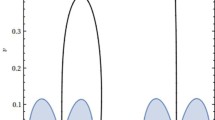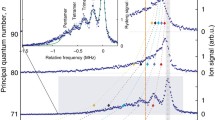Abstract
In our previous works we studied analytically helical Rydberg states and circular Rydberg states of two-Coulomb-center systems consisting of two nuclei of charges Z and Z′, separated by a distance R, and one electron. We obtained energy terms of these Rydberg quasimolecules for a field-free case, as well as under a static electric field or under a static magnetic field. In the present paper we study such systems under a laser field. For the situation where the laser field is linearly-polarized along the internuclear axis, we found an analytical solution for the stable helical motion of the electron valid for wide ranges of the laser field strength and frequency. We also found resonances, corresponding to a laser-induced unstable motion of the electron, that result in the destruction of the helical states. For the situation where such Rydberg quasimolecules are under a circularly-polarized field, polarization plane being perpendicular to the internuclear axis, we found an analytical solution for circular Rydberg states valid for wide ranges of the laser field strength and frequency. We showed that both under the linearly-polarized laser field and under the circularly-polarized laser field, in the electron radiation spectrum in the addition to the primary spectral component at (or near) the unperturbed revolution frequency of the electron, there appear satellites. We found that for the case of the linearly-polarized laser field, the intensities of the satellites are proportional to the squares of the Bessel functions J 2 q (s), (q = 1, 2, 3, ...), where s is proportional to the laser field strength. As for the case of the circularly-polarized field, we demonstrated that there is a red shift of the primary spectral component — the shift linearly proportional to the laser field strength. Under a laser field of a known strength, in the case of the linear polarization the observation of the satellites would be the confirmation of the helical electronic motion in the Rydberg quasimolecule, while in the case of the circular polarization the observation of the red shift of the primary spectral component would be the confirmation of the specific type of the phase modulation of the electronic motion. Conversely, if the laser field strength is unknown, both the relative intensities of the satellites and the red shift of the primary spectral component could be used for measuring the laser field strength.
Similar content being viewed by others
References
G. Nogues, A. Lupascu, A. Emmert, M. Brune, J.-M. Raimond, S. Haroche, in Atom Chips, edited by J. Reichel, V. Vuletic (Wiley-VCH, Weinheim, Germany, 2011), Chap. 10, Sect. 10.3.3
N. Kryukov, E. Oks, Can. J. Phys. 90, 647 (2012)
J.N. Tan, S.M. Brewer, N.D. Guise, Phys. Scr. T144, 014009 (2011)
N. Kryukov, E. Oks, Int. Rev. At. Mol. Phys. 3, 17 (2012)
J.S. Dehesa, S. Lopez-Rosa, A. Martinez-Finkelshtein, R.J. Janez, Int. J. Quantum Chem. 110, 1529 (2010)
T. Nandi, J. Phys. B 42, 125201 (2009)
M.R. Flannery, E. Oks, Eur. Phys. J. D 47, 27 (2008)
U.D. Jentschura, P.J. Mohr, J.N. Tan, B.J. Wundt, Phys. Rev. Lett. 100, 160404 (2008)
A.V. Shytov, M.I. Katsnelson, L.S. Levitov, Phys. Rev. Lett. 99, 246802 (2007)
M. Devoret, S. Girvin, R. Schoelkopf, Ann. Phys. 16, 767 (2007)
M.R. Flannery, E. Oks, Phys. Rev. A 73, 013405 (2006)
E. Oks, Eur. Phys. J. D 28, 171 (2004)
L. Holmlid, J. Phys.: Condens. Matter 14, 13469 (2002)
E. Oks, Phys. Rev. Lett. 85, 2084 (2000)
E. Oks, J. Phys. B 33, 3319 (2000)
S.K. Dutta, D. Feldbaum, A. Walz-Flannigan, J.R. Guest, G. Raithel, Phys. Rev. Lett. 86, 3993 (2001)
H. Carlsen, O. Goscinski, Phys. Rev. A 59, 1063 (1999)
J.E. Rice, E.S. Marmar, J.L. Terry, E. Källne, J. Källne, Phys. Rev. Lett. 56, 50 (1986)
G.R. Fowles, G.L. Cassiday, in Analytical Mechanics (Thomson Brooks/Cole, Belmont, 2005), Sect. 3.6
S.T. Thornton, J.B. Marion, in Classical Dynamics of Particles and Systems (Thomson Brooks/Cole, Belmont, 2004), Sect. 3.6
I.I. Sobelman, An Introduction to the Theory of Atomic Spectra (Pergamon, Oxford, 1972)
D.I. Blochinzew, Phys. Z. Sow. Union 4, 501 (1933)
E. Oks, in Plasma Spectroscopy. The Influence of Microwave and Laser Fields (Springer, New York, 1995), Sect. 3.1
Author information
Authors and Affiliations
Corresponding author
Rights and permissions
About this article
Cite this article
Kryukov, N., Oks, E. Analytical solutions for diatomic Rydberg quasimolecules in a laser field. Eur. Phys. J. D 68, 171 (2014). https://doi.org/10.1140/epjd/e2014-40765-7
Received:
Revised:
Published:
DOI: https://doi.org/10.1140/epjd/e2014-40765-7




